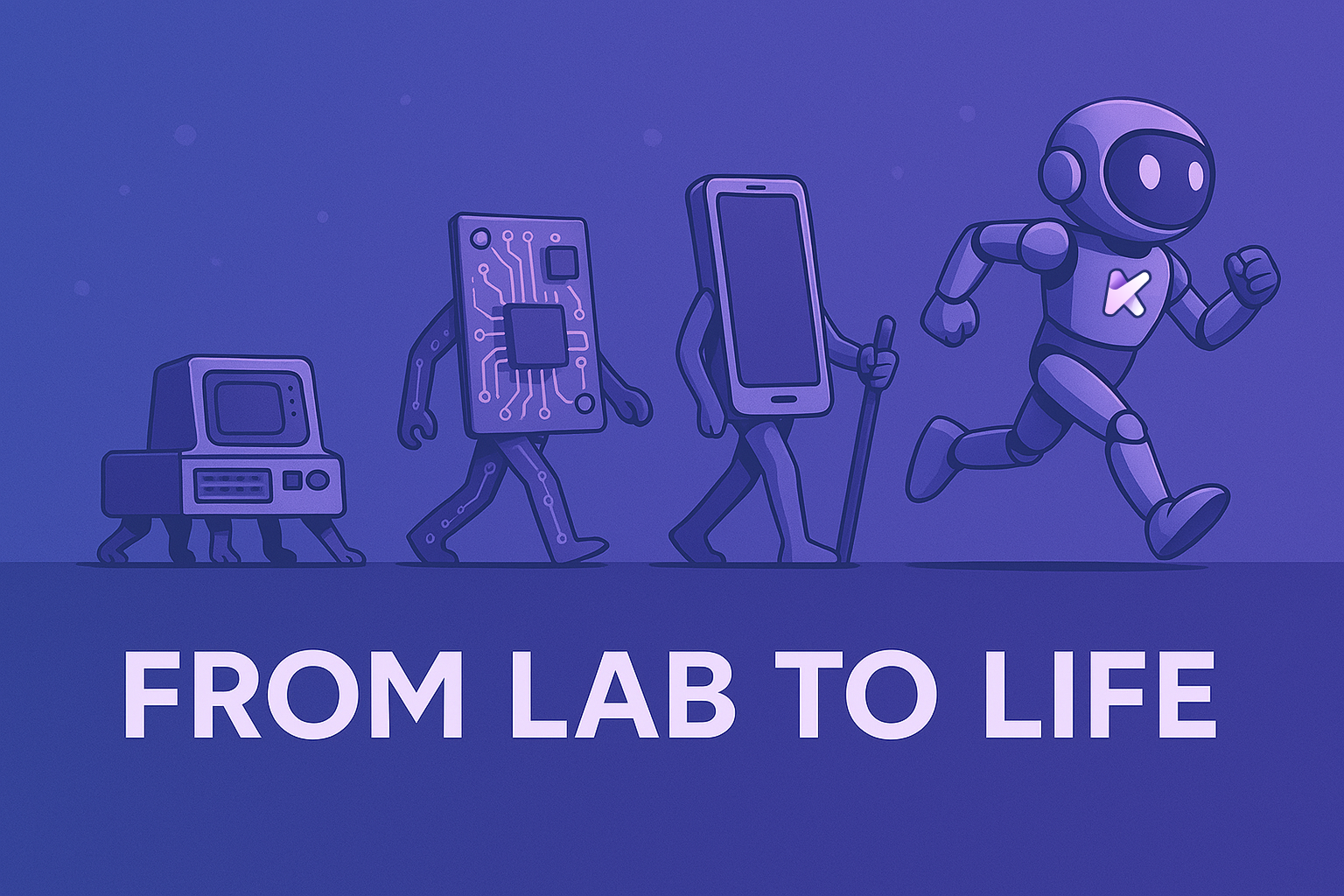From Lab to Life
0
0

Artificial intelligence is transforming our society at a dizzying pace, reshaping the way we interact with technology and unlocking unprecedented opportunities across all sectors. Amidst the spectacular advances of recent years and the promise of a future where AI could surpass human intelligence, we find ourselves at a pivotal moment in this technological revolution.
The Roots of Generative AI: A Story of Innovation
The history of artificial intelligence dates back to the 1950s, when its foundational concepts began to take shape. Pioneers such as Alan Turing and John McCarthy played a crucial role in laying the theoretical groundwork for machines capable of creating original content.
Early generative models were relatively simple by today’s standards. Techniques like Hidden Markov Models (HMMs) and Gaussian Mixture Models (GMMs) enabled basic data generation based on manual input. Though rudimentary, these approaches paved the way for more advanced architectures such as Restricted Boltzmann Machines (RBMs) and Variational Autoencoders (VAEs).
A true revolution in generative AI came in 2014 with the introduction of Generative Adversarial Networks (GANs) by Ian Goodfellow and his colleagues. This groundbreaking architecture, which pits a generator against a discriminator in a competitive loop, dramatically advanced our ability to create realistic synthetic images.
2022: The Year Everything Changed
The year 2022 marked a decisive turning point in the history of artificial intelligence, with breakthroughs that reshaped how we perceive and use this transformative technology.
Midjourney
In July 2022, Midjourney burst onto the generative AI scene as the first major platform for AI-driven image generation accessible to the general public. Its debut sparked an unprecedented wave of creativity, fueling AI-generated art exhibitions, NFT collections, and a mass production of visual content. The quality of generated images improved at lightning speed, blurring the lines between human and machine creativity.
ChatGPT
On November 30, 2022, OpenAI made headlines by releasing GPT-3 and the ChatGPT application, marking a monumental leap in conversational AI. This stunning reveal shattered expectations across the industry, proving that generative AI extends far beyond image creation into uncharted territories of language, reasoning, and interaction.
ChatGPT quickly emerged as a transformative milestone in conversational AI, not only passing the Turing Test with flying colors but also demonstrating remarkable contextual understanding, creativity, and reasoning abilities. More than just an enhancement of existing human-machine interactions, it redefined their very nature—ushering in a new era where the boundary between artificial and human communication becomes increasingly blurred.
The Rise of Open-Source Innovation
By 2023, open-source projects like Stable Diffusion, LLaMA, and Mistral sparked a paradigm shift in generative AI, previously dominated by a few major players. These pioneering initiatives democratized access to cutting-edge AI technology, fostering a vibrant ecosystem where researchers, developers, and enthusiasts from around the globe could collaborate and innovate.
This newfound openness dramatically accelerated innovation and broadened the scope of possible applications. It signaled a new era in which the evolution of AI is no longer confined to corporate labs but thrives in a decentralized, collaborative, and inclusive environment.
AI in 2025: Four Emerging Paradigms
In 2025, artificial intelligence continues its meteoric rise, evolving around four major paradigms that are redefining how we interact with technology.
Agentic AI: Autonomous Systems Driving Efficiency
Agentic AI marks a significant evolution in artificial intelligence—systems that not only analyze and predict but also act autonomously. These intelligent agents are built to perform complex tasks with minimal human intervention, unlocking new levels of efficiency and automation.
Platforms like OneReach and Manus AI exemplify this trend, integrating autonomous and semi-autonomous agents into complex workflows. This isn’t just an incremental improvement—it’s a paradigm shift. By offloading transactional and intricate tasks to AI, Agentic AI unleashes the full potential of generative intelligence while freeing up valuable human time for high-impact activities.
The power of Agentic AI to amplify performance, consistency and connectivity extends to all sectors. For example, in supply chains, Merlin Agentic AI is revolutionizing logistics by automating complex processes via their agent system, and we’re increasingly seeing leaders in this field like Kortexflow, which merges agentic AI with explainable AI (xAI), providing autonomous automation and analysis tools of unparalleled sophistication. These advances not only optimize current processes, but also create new possibilities in healthcare, education, scientific research and beyond.
Explainable AI: Toward Transparent and Understandable Intelligence
As AI systems grow more complex, ensuring their transparency and interpretability has become vital. Explainable AI (xAI) aims to demystify these systems by providing clear, accessible insights into how they function— from their design to their decision-making processes.
This approach answers a critical question: how can we trust systems whose reasoning remains opaque? Often referred to as “black boxes,” AI models conceal intricate internal mechanisms that users can’t readily understand. xAI seeks to “open” these black boxes, allowing users to understand why a particular output was generated and, when necessary, challenge or adjust the outcome.
Striking the right balance between performance and explainability remains a key challenge. The most powerful AI systems rely on complex models that are inherently difficult to interpret. This trade-off raises important concerns about accuracy, bias, and representativeness, especially when training data does not reflect real-world diversity.
In 2025, notable progress has been made: several new models now display their reasoning processes in real time. This innovation allows users to trace the logical flow behind an AI’s response—one of the core goals of xAI. Some pioneers, like our team at Cryptense, go even further. Our agentic engine integrates explainability and thought-chain visualization directly into its governance and control logic. Not only can users interpret model decisions, but oversight agents themselves can validate or correct the reasoning of sub-models. These breakthroughs demonstrate that high performance and transparency can coexist, paving the way for AI that is both powerful and trustworthy.
Edge AI: Intelligence at the Edge for Real-Time Responsiveness
Edge AI represents a modern approach in which algorithms and models are deployed at the network’s edge—close to the data source. This architecture enables devices to process information locally, eliminating the need for constant connectivity to centralized cloud servers.
This decentralized processing offers substantial benefits. First, it enables real-time decision-making, which is crucial for applications like autonomous vehicles and surveillance systems. Second, it enhances data privacy by keeping sensitive information on-device, reducing the risk of breaches.
Edge AI is born from the convergence of several technologies, including AI, the Internet of Things (IoT), edge computing, and embedded systems. These systems employ onboard algorithms to monitor and analyze sensor data—whether it’s temperature, facial recognition, motion detection, or other variables.
dLLMs: Image Diffusion Principles Brought to Language
Diffusion Language Models (dLLMs) are emerging as a major milestone in AI, applying image generation principles to natural language processing. Unlike traditional autoregressive models that generate text word by word, dLLMs use a “coarse-to-fine” approach: they first produce a rough sketch of the full sequence, then iteratively refine it.
This process, introduced to the public by Inception Labs in March 2025, not only accelerates generation but also significantly enhances coherence across entire texts.
This architecture delivers significant benefits. Generating complete sequences simultaneously makes dLLMs up to ten times faster than traditional models while reducing computational costs. Their holistic view enhances consistency in long or complex outputs, making them ideal for advanced reasoning, scientific research, financial analysis, and content creation.
dLLMs are poised to become a foundational pillar of Agentic xAI, merging fast processing with clear reasoning. Their parallel design allows agents to both execute and explain decisions in real time, crucial for autonomous systems requiring live evaluation. Their energy efficiency also makes them ideal for large-scale deployment of eco-friendly AI agents. Innovative tools are already evaluating theres synergies in the Web3 ecosystem, optimizing interactions between decentralized agents for rapid on-chain data analysis while maintaining full auditability of decision logic.
Looking Toward 2030: Between Promise and Challenge
Technological Singularity: Imminent Reality or Persistent Myth?
By combining computational power, transparency, energy efficiency, and speed of execution, the building blocks for a new generation of artificial intelligence applications could emerge sooner than anticipated. The concept of technological singularity—the hypothetical moment when AI surpasses human intelligence and begins self-improving autonomously—continues to spark both excitement and caution. Some experts predict this critical threshold might be crossed as early as 2029, leading to a radical transformation of our relationship with technology.
Web3 as the Experimental Playground
Such a development would present vast opportunities in both traditional markets and the emerging Web3 ecosystem. The rise of autonomous intelligence capable of reasoning, collaborating, and even innovating would profoundly alter decision-making processes, resource allocation, and financial risk management. Traditional investors could witness the emergence of entirely new financial models with capabilities previously unimaginable.
We believe the Web3 sector, disruptive, decentralized, and inherently agile, could serve as the ultimate experimental laboratory for deploying these innovations. By integrating the autonomy of intelligent agents, the transparency offered by explainable AI (xAI), and the speed of architectures such as dLLMs, along with the multitude of innovations expected in the coming market cycle, artificial intelligence will profoundly reshape our approach to the crypto ecosystem and decentralized finance.
Highly customizable automated portfolio managers, intelligent agents, automated protocols for risk analysis and opportunity detection, capable of reacting instantly to evolving contexts and interacting with one another while remaining fully transparent and auditable, the possibilities are endless.
Thus, far from mere futuristic speculation, technological singularity could represent a historic turning point in investment, unlocking unprecedented opportunities while also posing significant challenges related to governance, security, ethics, and regulation. Already today, with pioneering projects, the Web3 sector stands at the forefront of this revolution, agilely exploring uncharted territories and laying the groundwork for financial and technological innovations that could entirely redefine our relationship to capital, risk, and value creation.
At a Crossroads
Artificial intelligence stands at a defining crossroads. From its conceptual roots in the 1950s to today’s sophisticated generative systems, we are witnessing an unprecedented acceleration of this technological revolution.
The coming years will be critical in shaping our coexistence with intelligent systems. Between the promise of ubiquitous AI enhancing our capabilities and the threat of a singularity beyond our control, the future depends on our collective ability to establish ethical and regulatory guardrails that ensure AI remains a force for good.
The challenge is no longer just technological, it’s deeply societal: how do we harness AI’s transformative power while safeguarding our autonomy, privacy, and core human values? The answer to that question will define not only the future of artificial intelligence, but the future of our civilization itself.
About Kryll
Kryll³ is a pioneering platform that integrates generative artificial intelligence innovations into the fields of Web3 intelligence and decentralized finance. Thanks to our advancements in Agentic AI, we develop cutting-edge solutions to support, educate, and assist crypto investors in their needs. Our commitment to exploring state-of-the-art AI technologies has been recognized by leading tech players such as Google and Anthropic, with whom we collaborate on various research topics.
0
0
 Manage all your crypto, NFT and DeFi from one place
Manage all your crypto, NFT and DeFi from one placeSecurely connect the portfolio you’re using to start.









